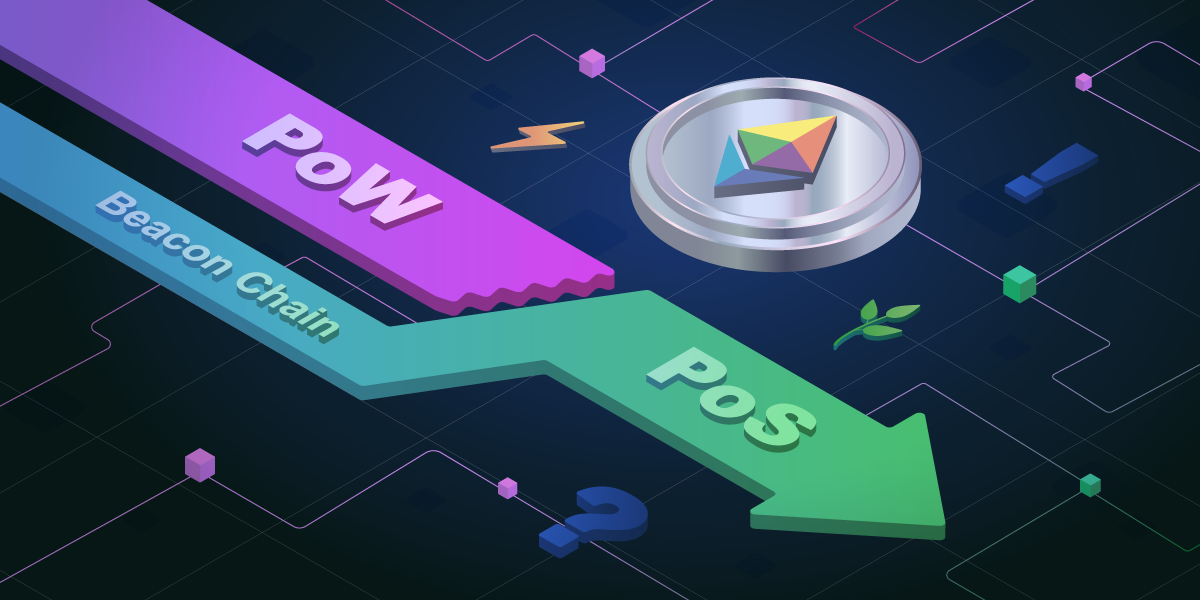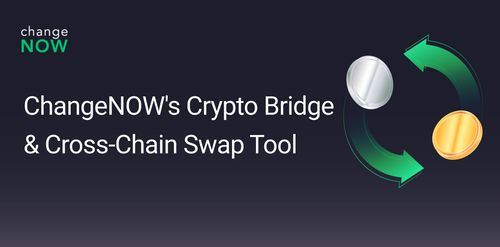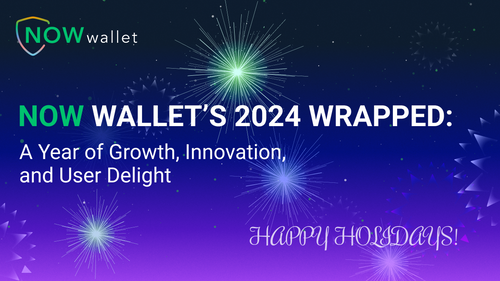The Merge Explained: One Step Closer to Scalable Ethereum
Vitalik Buterin says that after the update, the network will be only 55% complete in terms of development – and it’s true that it won’t instantly reduce gas fees and increase network’s throughput. The Merge pursues another goal.
On September 15th, two things will happen. First, Ethereum mining will become obsolete, reducing the network's energy consumption by 99.95%. Second, the Merge will lay the ground for further scaling updates, unleashing Ethereum's full potential as a backbone of the decentralized internet of the future.
In this article, we explain the Merge and the context behind it, outline the post-merge updates, and guide you into using the PoS Ethereum.

The Merge In a Nutshell
Ethereum, the second-largest cryptocurrency by market cap, is changing its consensus algorithm – the way transactions are validated on the blockchain. Since its launch, Ethereum has been running on the battle-tested Proof of Work consensus, just like Bitcoin.
Miners had to solve an array of math problems faster than their competitors in order to validate blocks and receive their reward. To win this competition, they leveraged powerful equipment that consumed tremendous amounts of energy.
Such a model proved too cumbersome and inefficient for Ethereum’s thriving economy. Due to low throughput, the network frequently got congested, resulting in fees of $50-80 per single transaction. Poor scalability threatened to make Ethereum uncompetitive compared to newer public blockchains.
In 2020, Beacon Chain was launched – an Ethereum network running on the Proof of Stake consensus algorithm. This mechanism eliminates the energy-consuming hardware competition, and it gives the right to validate blocks to those who have a stake (locked funds) in the Ethereum network.
This September, the current Ethereum mainnet will merge with the Beacon Chain, and the entire network will start running on Proof of Stake. This will remove mining and set the stage for further scaling updates – those that will increase Ethereum throughput and reduce gas fees over the next 1-2 years.
Now, let’s break this down.
The Ethereum Vision – Why Does ETH Abandon Proof of Stake?
According to the Ethereum Vision, there are three main challenges that the network addresses by introducing Proof of Stake:
- Clogged network. Ethereum is home to a huge portion of DeFi, GameFi, NFT, and metaverse industries. The network capacity is too poor to cover such a high demand, so Ethereum needs to improve its speed for a global user base.
- Too much disk space. As the network grows, the Ethereum blockchain size is rapidly increasing, and it becomes too hard to store it on a single device to run a node. To ensure decentralization, Ethereum needs to lower the hardware requirements for node operators.
- Too much energy. With Proof of Work, Ethereum produces over 12 million tons of CO2 per year. The network needs to become more sustainable. Once the Ethereum mainnet implements the transition to PoS, one node won’t consume more energy than a regular PC.
An easy but ‘naive’ solution, according to the Ethereum vision, would be to scale the network in a centralized manner. However, it is decentralization that ensures censorship resistance, openness, data privacy, and nearly unbreakable security – things Ethereum is loved for.
According to the blockchain trilemma, there are three key parameters of a network – security, scalability, and decentralization, but only two of the three can be improved at a time. The Merge and the subsequent sharding are meant to challenge this statement.
The Merge – What Is It, Exactly?
In December 2020, Ethereum’s devs launched Beacon Chain – a Proof of Stake blockchain running separately from the Ethereum mainnet. A staking smart contract was deployed in this blockchain, allowing users to freeze their coins and receive rewards for validating blocks. As of September 13, 2022, there are 425K+ validators who stake over $13.6M worth of Ether in the Beacon Chain.
During the Merge, the current Ethereum mainnet, dubbed as Eth1, won’t simply change its consensus algorithm to PoS. It will continue to be part of the Ethereum blockchain as an ‘execution layer’, where all transactions and smart contracts will operate. Beacon Chain, or Eth2, will become the** ‘consensus layer’**, responsible for validating blocks. Thus, Eth1 and Eth2 will merge into one single Ethereum, and Proof of Work will be abandoned.
Safe Merge has been ensured by extensive testing, bug bounties, and several merges of Ethereum testnets.
In Proof of Stake Ethereum, the ‘weight’ of a validator’s vote will depend on how much Ether they are staking. The size of the stake also defines the validator’s reward. Besides reduced energy consumption and hardware requirements, Proof of Stake makes Ethereum even more secure. The network will become more resistant to attacks, since it’s close to impossible to accumulate enough resources to have a big-enough stake to control the blockchain.
Scaling Ethereum After the Merge
The next big event after the Merge is the Shanghai upgrade, scheduled to take place 6-12 months later. It will enable unstaking (we’ll get back to this later), improve the Ethereum Virtual Machine, and reduce gas fees for Layer 2 transactions.
Together with the Merge, Shanghai will lay the ground for sharding – the next major update that will increase scalability and throughput of the network. These post-merge events will implement Ethereum’s vision of becoming “powerful enough to help all of humanity.”
Sharding will make nodes lightweight and accessible
As mentioned before, Ethereum blockchain size is increasing, and nodes struggle to keep it in a single place. Sharding splits the transaction database, so the node can operate with just a fraction of it. It will become possible to run Ethereum from a PC or even mobile phone.
Decentralization and room for growth
As nodes become more accessible, more people will run them. More validators, in turn, ensure better decentralization and higher security. A splitted database will also keep providing good throughput even while transaction load and the blockchain size are growing.
Sharding and Rollups
Sharding will operate together with rollups – a technology that bundles (or rolls up) hundreds of Layer-2 transactions (like on Polygon or Arbitrum) into one on Ethereum mainnet. Gas fees for one Ethereum transaction are split between a hundred on L2. Moreover, sharding breaks large amounts of data needed by rollups into little pieces, thus reducing the burden.
PoS-based Beacon Chain as a consensus layer of Ethereum will coordinate validators between shards – that’s why the Merge is necessary to scale the network.
Sharding is to be implemented during 2023 and 2024.
Do I Have to Prepare for the Merge as a User?
Whether you keep ETH coins in your wallet, own LP or any other ERC20 tokens, you don’t have to do anything before or after the Merge. In terms of user experience, the Merge will go unnoticed, and you will keep access to your assets just the way you did it before the update.
Will the Merge Reduce Gas Fees?
There are several popular misconceptions about the Merge, and one of them says that the update will immediately cut gas fees. However, there will be no such effect right away. The Merge lays the ground for sharding and other future updates that will scale Ethereum and reduce gas fees, but these effects won’t take place directly from switching to Proof of Stake.
Gas fees are determined by supply (network capacity) and demand (transactions count). Currently, when trading activity rises, the supply can’t cover the demand, the network congests, and fees skyrocket. Ethereum’s scaling will help increase supply to freely fulfill huge demand and keep fees low, but that will come with further scaling updates after the Merge.
Will the Merge Speed Up Ethereum Transactions?
The switch to Proof of Stake does not increase block size or dramatically reduce block time – the speed won’t change significantly after the Merge. The block time is supposed to decrease from 13.3 to 12 seconds, so only a 10% acceleration should be expected.
How Can I Stake Ethereum?
Instead of mining Ethereum, you will be able to stake it on mainnet following the Merge. There will be no need for expensive hardware anymore, but there are still certain requirements.
Solo staking (current APR about 4.1%) comes with the largest cost:
- The minimum size of stake is 32 ETH.
- There are responsibilities of running a validator. You have to run an Ethereum node and maintain its proper operation 24/7.
- Staked funds are immovable. Once you start staking, you won't be able to unstake your coins before the Shanghai upgrade that is to take place 6-12 months after the Merge. However, staking rewards are liquid and will start accumulating in your wallet right away.
Pool staking allows you to invest much less than 32 ETH – but there’s still no unstaking, and the pool will charge a fee.
You can also stake on a crypto exchange. Any amount of ETH can be staked, but again, you can’t unlock the coins before Shanghai, and the exchange may charge high fees. This goes with traditional risks of centralized crypto exchanges who maintain full control over your coins.
Liquid staking
Liquid staking is a decent alternative where you don’t have to completely freeze your coins. Here’s how it works: you stake Ether in a third-party protocol, it issues you a tokenized version of the staked funds, and you can store, invest, or trade them.
Lido is one of the most popular liquid staking protocols. When you stake your ETH there, it sends you stETH tokens in return, which you can use for lending, collateral, and more. Your daily staking rewards will accumulate in your Ethereum wallet, so you can access your earnings anytime. ETH can be redeemed back for stETH at any moment.
Will Ethereum Hard Fork, and What is ETHPoW?
At the end of June, an influential miner Chandler Guo expressed an idea to create an Ethereum hard fork, a coin named ETHPoW (ETHW), that would continue to run on the Proof of Work consensus even after the Merge. His supporters, a small but vocal group of Ethereum critics, said that the hard fork is “inevitable” as it sees huge demand in the community.
The idea, however, was met with criticism. The head of ETC Cooperative Bob Summerwill wrote in an open letter to Guo that the miners simply don’t have time to deal with all tech issues to run the fork. But even if ETHPoW goes live, its benefits for users are highly questionable – the largest stablecoins, NFTs, and DeFi protocols won’t be interested in deploying on an obsolete chain, said Summerwill. The experts of CoinShares, a digital asset management firm, called the potential PoW hard fork “unviable.”
In turn, ETHW supporters claimed to have created a dedicated dev team that had already prepared for the fork; there are ETHPoW futures in the market that are now trading at $29.
While no one knows whether ETHW will ever exist, ChangeNOW has prepared for the Merge and the potential fork. The entire ChangeNOW ecosystem including NOW Wallet, NOWPayments, and NOWNodes will operate in normal mode when Ethereum goes PoS, and ETHW will be listed if its mainnet goes live.
How Will the Merge Affect the Market?
On August 26, the Federal Reserve Chairman Jerome Powell confirmed: the Fed will keep increasing interest rates before high inflation is tackled. The crypto market, still not having fully recovered after the summer liquidity crisis, reacted with another price drop.
The Merge, however, is something that can help revive the market. “First of all, the argument that Ethereum, DeFi, and NFTs are harmful to the environment will be put to rest. Consequently, ESG-compliant institutions will find Ether an appealing investment,” – says Mike Ermolaev, head of PR at ChangeNOW. The issuance of ETH coins is supposed to decrease, which will eventually help push the Ethereum price up. It is unlikely that the Merge will immediately end the crypto winter, but it does give hope to breathe new life into the cryptocurrency market.



